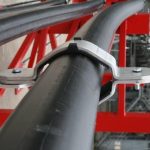Earthing down is an important concept as far as working in high voltage system is concerned. It is an additional safety procedure for high voltage systems. Earthing down ensures all the stored electrical energy in the circuit insulation is safely discharged to earth. Hence earthing ensures that isolated electrical equipment is safe to work.
Note: Always check the circuit using ‘live line tester’ after isolating the circuit. Earthing down to be carried out only after confirming that the circuit is dead.
Importance of Earthing Down
Higher insulation resistance is required in high voltage system. This results in higher insulation capacitance. We have the equation for stored energy in the system,
E = ( C x V² ) / 2
Where, E = Stored Energy in Joules
C = Insulation Capacitance
V = Voltage
In the formula square of the voltage is used. We know that the voltage itself is very high in HV system. These factors lead to heavy stored energy in the system which will be life threatening.
In a high voltage system there are two types of earthing.
1. Circuit Earthing
2. Busbar Earthing
Circuit Earthing
All the three phases or conductors are connected to a heavy earth connection after circuit breaker has been racked out. This is carried out using a key, which is then locked in the key safe. It is impossible to rack in the circuit breaker without removing this earthing down connection using the same key.
Busbar Earthing
When we have to work on part of the busbar itself, make sure all the incoming sources of electricity are completely isolated. These sources are generator cables, transformer connections, bus tie breaker, etc. Each phase earthing down to be done using portable leads. These portable leads give a visible confirmation of earthing down.


